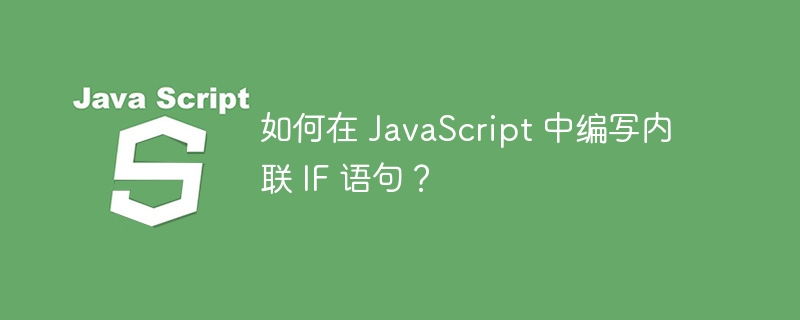如何在 JavaScript 中编写内联 IF 语句?

条件语句是任何编程语言中最重要和最基本的概念。 if-else 语句允许我们有条件地执行任何代码块。我们可以在大括号中定义if语句的条件,如果条件成立,则执行if块的代码;否则,它执行 else 块的代码。
在这里,我们演示了 if-else 语句在 JavaScript 中的工作原理。
if (condition) {
// code to execute when the condition becomes true
} else {
// code to execute when the condition becomes false
}
从上面的代码中,用户可以了解if-else语句的语法。
如果我说你可以把上面五行代码写成一行呢?是的,您可以使用内联 if 语句来做到这一点。
语法
用户可以按照以下语法在 JavaScript 中使用内联 if 语句。
Condition? code - block - 1 : code - block - 2
在上面的语法中,条件是一个表达式。当条件表达式为 true 时,执行代码块 1;否则,它执行代码块2。
如果我们将内联 if 语句与 if-else 语句进行比较,则 code-block-1 是 if 语句的代码,code-block-2 是 else 语句的代码。
示例
在下面的示例中,我们将学习内联 if 语句的基本用法。我们使用了条件“10===10”,如果条件为 true,则会打印“10 等于 10”;否则,它将打印“10 is not equal to 10”。
在输出中,用户可以观察到它打印了“10 is equal to 10”,因为条件始终评估为 true。
<html>
<body>
<h2>Using the <i> inline if statement </i> in JavaScript</h2>
<div id = "output"> </div>
<script>
let output = document.getElementById('output');
let result = 10 === 10 ? "10 is equal to 10." : "10 is not equal to 10.";
output.innerHTML += "The value of the result variable: " + result;
</script>
</body>
</html>
示例
在下面的示例中,我们创建了数字数组。此外,我们还创建了 func1() 和 func2() 函数,它们使用作为参数传递的值来打印不同的消息。
我们使用 forEach() 方法循环遍历数组。在 forEach() 方法的回调函数中,我们检查数字是否能被 10 整除,则调用 func1() 函数;否则,调用 func2() 函数。
<html>
<body>
<h2>Using the <i> inline if statement </i> in JavaScript</h2>
<div id = "output"> </div>
<script>
let output = document.getElementById('output');
function func1(value) {
output.innerHTML += "The func1() is executed for the value " + value + "<br>";
}
function func2(value) {
output.innerHTML += "The func2() is executed for the value " + value + "<br>";
}
let numbers = [10, 30, 43, 50, 64, 76, 87];
numbers.forEach((num) => {
num % 10 == 0 ? func1(num) : func2(num);
})
</script>
</body>
</html>
示例
在下面的示例中,我们使用 if-else 语句和内联 if 语句检查年份是否为闰年。 checkYear() 函数使用 if-else 语句来确保作为参数传递的年份是否为闰年。
在 checkInlineYear() 函数中,我们实现了与 checkYear() 函数中相同的逻辑,但我们将 if-else 语句转换为内联 if 语句。用户可以看到我们如何将九行写在一行中。
用户可以观察到这两个函数对于任何年份值都给出相同的输出。
<html>
<body>
<h3>Using inline if statement to check whether year is leap year in JavaScript</h3>
<div id = "output"> </div>
<script>
let output = document.getElementById('output');
function checkYear(year) {
// if the year is divisible by 400, it is a leap year.
if (year % 400 == 0) {
return true;
// if the year is divisible by 400 and by 100, it is not a leap year.
} else if (year % 100 == 0) {
return false;
// if the year is divisible by 400, not divisible by 100, and divisible by 4, it is a leap year.
} else if (year % 4 == 0) {
return true;
} else {
return false;
}
}
function checkInlineYear(year) {
return year % 400 == 0 ? true : year % 100 == 0 ? false : year % 4 == 0 ? true : false;
}
output.innerHTML += "Outputs using the checkYear() function. <br> ";
output.innerHTML += "The 2023 is leap year :- " + checkYear(2020) + "<br>";
output.innerHTML += "The 3000 is leap year :- " + checkYear(3000) + "<br>";
output.innerHTML += "<br>";
output.innerHTML += "Outputs using the checkInlineYear() function. <br> ";
output.innerHTML += "The 2023 is leap year :- " + checkInlineYear(2020) + "<br>";
output.innerHTML += "The 3000 is leap year :- " + checkInlineYear(3000) + "<br>";
</script>
</body>
</html>
用户学会了在 JavaScript 中使用内联 if 语句。我们可以观察到,内联 if 语句使代码更清晰、更具可读性,并且在相同的逻辑下编写更少的代码行总是好的。
以上是如何在 JavaScript 中编写内联 IF 语句?的详细内容。更多信息请关注PHP中文网其他相关文章!

热AI工具

Undresser.AI Undress
人工智能驱动的应用程序,用于创建逼真的裸体照片

AI Clothes Remover
用于从照片中去除衣服的在线人工智能工具。

Undress AI Tool
免费脱衣服图片

Clothoff.io
AI脱衣机

AI Hentai Generator
免费生成ai无尽的。

热门文章

热工具

记事本++7.3.1
好用且免费的代码编辑器

SublimeText3汉化版
中文版,非常好用

禅工作室 13.0.1
功能强大的PHP集成开发环境

Dreamweaver CS6
视觉化网页开发工具

SublimeText3 Mac版
神级代码编辑软件(SublimeText3)

热门话题
 在JavaScript中替换字符串字符
Mar 11, 2025 am 12:07 AM
在JavaScript中替换字符串字符
Mar 11, 2025 am 12:07 AM
JavaScript字符串替换方法详解及常见问题解答 本文将探讨两种在JavaScript中替换字符串字符的方法:在JavaScript代码内部替换和在网页HTML内部替换。 在JavaScript代码内部替换字符串 最直接的方法是使用replace()方法: str = str.replace("find","replace"); 该方法仅替换第一个匹配项。要替换所有匹配项,需使用正则表达式并添加全局标志g: str = str.replace(/fi
 构建您自己的Ajax Web应用程序
Mar 09, 2025 am 12:11 AM
构建您自己的Ajax Web应用程序
Mar 09, 2025 am 12:11 AM
因此,在这里,您准备好了解所有称为Ajax的东西。但是,到底是什么? AJAX一词是指用于创建动态,交互式Web内容的一系列宽松的技术。 Ajax一词,最初由Jesse J创造
 如何在浏览器中优化JavaScript代码以进行性能?
Mar 18, 2025 pm 03:14 PM
如何在浏览器中优化JavaScript代码以进行性能?
Mar 18, 2025 pm 03:14 PM
本文讨论了在浏览器中优化JavaScript性能的策略,重点是减少执行时间并最大程度地减少对页面负载速度的影响。
 如何使用浏览器开发人员工具有效调试JavaScript代码?
Mar 18, 2025 pm 03:16 PM
如何使用浏览器开发人员工具有效调试JavaScript代码?
Mar 18, 2025 pm 03:16 PM
本文讨论了使用浏览器开发人员工具的有效JavaScript调试,专注于设置断点,使用控制台和分析性能。
 jQuery矩阵效果
Mar 10, 2025 am 12:52 AM
jQuery矩阵效果
Mar 10, 2025 am 12:52 AM
将矩阵电影特效带入你的网页!这是一个基于著名电影《黑客帝国》的酷炫jQuery插件。该插件模拟了电影中经典的绿色字符特效,只需选择一张图片,插件就会将其转换为充满数字字符的矩阵风格画面。快来试试吧,非常有趣! 工作原理 插件将图片加载到画布上,读取像素和颜色值: data = ctx.getImageData(x, y, settings.grainSize, settings.grainSize).data 插件巧妙地读取图片的矩形区域,并利用jQuery计算每个区域的平均颜色。然后,使用
 如何构建简单的jQuery滑块
Mar 11, 2025 am 12:19 AM
如何构建简单的jQuery滑块
Mar 11, 2025 am 12:19 AM
本文将引导您使用jQuery库创建一个简单的图片轮播。我们将使用bxSlider库,它基于jQuery构建,并提供许多配置选项来设置轮播。 如今,图片轮播已成为网站必备功能——一图胜千言! 决定使用图片轮播后,下一个问题是如何创建它。首先,您需要收集高质量、高分辨率的图片。 接下来,您需要使用HTML和一些JavaScript代码来创建图片轮播。网络上有很多库可以帮助您以不同的方式创建轮播。我们将使用开源的bxSlider库。 bxSlider库支持响应式设计,因此使用此库构建的轮播可以适应任何
 如何使用Angular上传和下载CSV文件
Mar 10, 2025 am 01:01 AM
如何使用Angular上传和下载CSV文件
Mar 10, 2025 am 01:01 AM
数据集对于构建API模型和各种业务流程至关重要。这就是为什么导入和导出CSV是经常需要的功能。在本教程中,您将学习如何在Angular中下载和导入CSV文件







